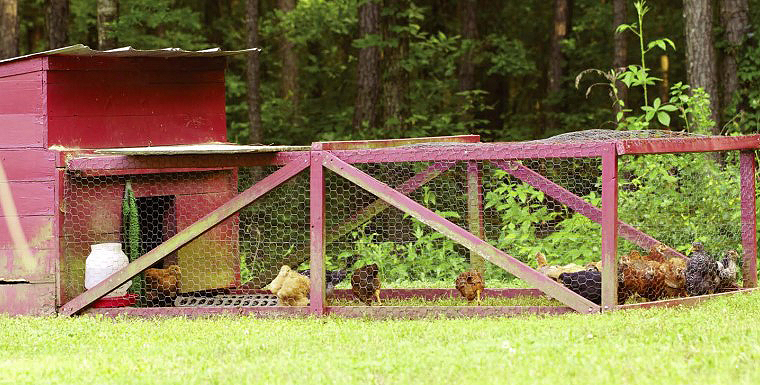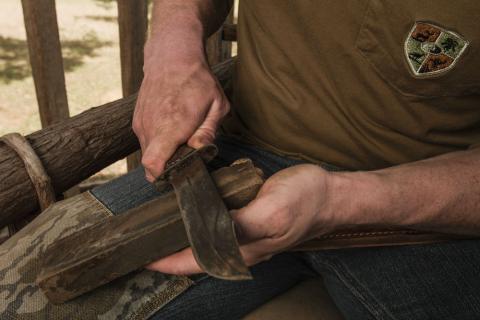Stacy Harris | Originally published in GameKeepers: Farming for Wildlife Magazine. To subscribe, click here.

Raising chickens is an amazing adventure. Chickens are one of the most beneficial domesticated creatures in the world, by far. They are not only amusing to watch, but they are also natural tillers and soil builders of the land, and amazing food producers. The health benefits of what they generate are unparalleled considering that they produce exceptionally nutritious eggs and meat. Once upon a time, just about every American harvested their own meat by a combination of hunting wild game, raising chickens or other livestock, as well as fishing. It is quite simple to begin raising chickens for meat and I believe that is why there is a comeback to the backyard chicken coop.

learn how to be self-reliant and they gain confidence
by contributing to the welfare of the family. Here is the
author’s youngest daughter Milly, playing with a few
chicks.
The world-wide preferred free-range meat to raise has always been chickens. The benefits of raising your own chickens far outweigh the time and resources it takes to raise them. The eggs alone are worth any amount of effort involved. Fresh eggs are one of the healthiest proteins available and are a large part of my family's diet. Free-range chickens produce eggs that provide essential amino acids for humans and contain an exceptional amount of vitamins and minerals necessary for excellent health. The meat from chickens allowed to forage and scratch up protein-filled bugs or fed grains in your yard is far and away healthier than those caged birds bought in most large markets. They have less cholesterol and fat and more folic acid, and Omega-3 fatty acids. Furthermore, you know when raising your own chickens that they are not pumped full of hormones and antibiotics, nor do they contain Genetically Modified Organisms (GMOs).
Not only are chickens fantastic fuel for the body, but they also aid us in land management. Chickens naturally till as they scratch and peck the land. As your vegetable garden matures this scratching and pecking adds aeration (and their natural fertilizer) to the soil. Most of the time chickens will not eat the mature vegetables; they would rather scratch for insects. Some people do not let chickens in their gardens, but if controlled, they can be very beneficial.
The manure also aids in the fertility of the garden (mulch would need to be added to the fresh manure to hold the nitrogen and other nutrients in stable condition). If you want to keep them out of your garden, you can add their manure into your compost bin. With chickens in our backyard, we rarely waste any food. They thankfully consume left-over from the kitchen as well as weeds from the garden.
For these reasons, raising chickens, even for those in urban neighborhoods, is becoming more and more the norm. I could not be more excited about this movement back to the self -sufficient pattern of hunting and gathering for one's own sustenance. Children learn through example and experience how to be self-reliant and they gain confidence by contributing to the welfare of the family. To me, this promotes family unity, usefulness, and service to others and teaches them how to eat healthily.
To get started, first choose what breeds you would like to raise. My favorite chickens include time-proven varieties including Barred Rocks, Rhode Island Reds, and New Hampshire Reds. I love the fact that my ancestors were caring for the same types of chickens that I am raising. They are also good dual-purpose birds, in that they are great layers and great table birds (meat birds). Many people favor Buff Orrington’s and Americanas. The Buff Orrington is a good layer and a gentle breed, but they are also escape artists and hard to corral back into the coop. Americanas are valued for their gorgeous light green eggs. Most local coops will have baby chicks for purchase or you can buy them on-line. Find a brooder (an enclosure that will house your new chicks), a lamp for heat, a brooder-size food and water dispenser, and wood shavings for the bottom of the brooder.
While waiting for your baby chicks to arrive, gather supplies. Just like us, they need shelter, food, and water. A brooder can be made from a large plastic storage bin, old fish tank, cardboard or wooden box, or even a kiddie-pool. I have a homemade brooder with a light that I can adjust to the best height to give the perfect amount of heat to my chicks. I let my chicks tell me when to adjust the heat. I know that the chicks are too hot if they hover toward the edge of the brooder or they are too cold if they are all clustered together under the lamp. The chicks will need less heat every week and will soon outgrow the brooder.
After about a month the chicks will be feathered out and in need of a larger space. I have a chicken coop but grown hens occupy the coop so I must move my chicks to a chicken tractor. A chicken tractor is a moveable pen that allows your chickens to forage on new grass or vegetation every day or every few days as you move it around your yard. This could be a permanent location for your chickens if you do not need but a few eggs a day. I use my chicken tractor as a temporary shelter for my chicks to allow them to grow enough to defend themselves from the older hens in the coop.

Chicken tractors are not hard to build and plans are available on the internet. We built ours from scrap wood and old bicycle tires and it has lasted for years. When building a chicken coop or tractor, the rule of thumb is to give each chicken two-to-three square feet inside the hen house and four-to-five square feet in the chicken run or outside the hen house. They will need a place to roost, chicken pellets for food, and plenty of water.
Five or six months after you bring your carton of peeping chicks home, you will get your first egg! That is an exciting day—at least it was in my household. The first eggs are about half the size of a normal egg but taste delicious. Your chickens will lay eggs as long as they get enough light (14 hours a day) and the chickens are not stressed by not having enough water or food to eat. They seem to lay better for me if I feed them table scraps and extras from the garden. Their laying will considerably slow down in the winter months due to lack of light unless you decide to place an artificial light in the coop.

easy to raise. Some make great table fare, some
produce great eggs while a few supply both.
There also comes a time when the chickens will molt. This happens after 12-to-14 months or so. Chickens are giving their energy to changing their suit of feathers and after several months they will begin laying again. After about 18 months, their laying will slow considerably and it will be time to think about getting a new set of baby chicks and start the process over again. Of course, you could get a rooster and an incubator to raise your very own baby chicks!
I have never met anyone that is sorry that they are raising chickens. There is just something about knowing what has gone into (or not gone into) the food that inspires folks like me to raise chickens, harvest eggs, and bring to the table the vegetables and fruits that we have grown or foraged.
Through the years I have made it my ambition to provide healthy, fabulous-tasting food for my family. Wild game, fresh heirloom vegetables and fruits, fresh eggs, and old hens and roosters have become a part of everyday food for my family. This healthy freeing lifestyle brings us one step closer to the self-sufficiency that our ancestors enjoyed. Bring chickens to your backyard and enjoy them from the yard to the table.




























